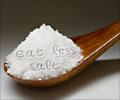Common salt could be the answer of producing low cost high-tech gadgets after researchers found that it can allow mass commercial production of silicon nanostructure.

The molten salt can then be washed away by dissolving it in water, and it can be recycled and used again.
The concept, surprising in its simplicity, should open the door to wider use of these remarkable materials that have stimulated scientific research all over the world.
David Xiulei Ji, an assistant professor of chemistry in the OSU College of Science, said that this could be what it takes to open up an important new industry and there are methods now to create silicon nanostructures, but they are very costly and can only produce tiny amounts.
He said that the use of salt as a heat scavenger in this process should allow the production of high-quality silicon nanostructures in large quantities at low cost and if they can get the cost low enough many new applications may emerge.
Existing technologies to make silicon nanostructures are costly, and simpler technologies in the past would not work because they required such high temperatures. Ji developed a methodology that mixed sodium chloride and magnesium with diatomaceous earth, a cheap and abundant form of silicon.
Advertisement
The sodium chloride did not contaminate or otherwise affect the reaction, researchers said. Scaling reactions such as this up to larger commercial levels should be feasible, they said.
Advertisement
The findings have been published in Scientific Reports, a professional journal.
Source-ANI









